Most fluids (air, water, etc.) are transparent, thus their flow patterns are invisible to us. Flow visualization is used to make flow patterns visible so that we can visually acquire qualitative and quantitative flow information. A vector field (or flow field) is a mapping F(P)=V that assigns a vector V to each point P in the domain U. In 2D, the domain U is represented by a 2D grid, and each cell of this grid is assigned a vector that indicates both direction and magnitude of the flow at the center of that cell, as shown in the figure below. Vectors at positions rather than cell centers are linearly interpolated. When all the time derivatives of a flow field vanish, the flow is considered to be a steady flow. In other words, steady flow refers to the condition where the fluid properties at a point in the system do not change over time. Otherwise, the flow is called an unsteady flow. The most common way to visualize a flow field is to depict the "paths" that fluid elements will follow at any point in time. These paths are called streamlines (for a steady flow field) or pathlines (for an unsteady flow field).
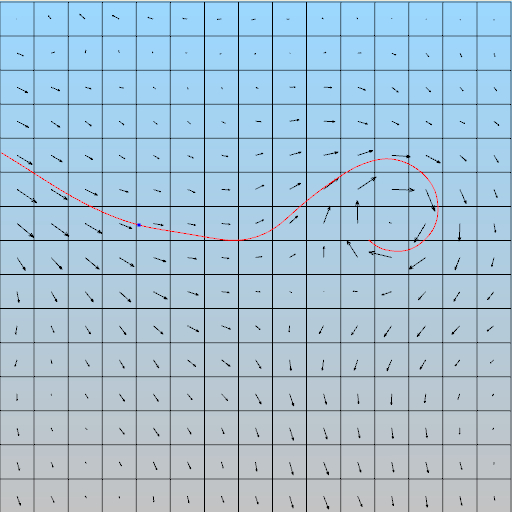
A line integral convolution or (LIC) image uses a dense texture to depict a complete overview of a 2D flow field. It works by adding a random static pattern of black-and-white paint sources to visualize the flow field. As the flow passes by the sources each fluid particle picks up some of the source intensity. The result is a random striped texture where points along the same streamline tends to have similar intensities.
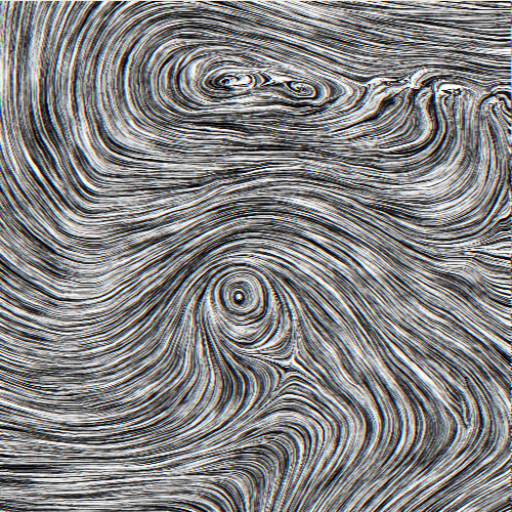
A streamline is a curve tangent to the flow field everywhere, as shown in the figure below. The streamlines are drawn in red while the vectors are drawn in blue. Intuitively, a streamline is the path that a massless particle will follow if released in a steady flow field. If a small ball is placed into a water flow, and assuming the water flow does not change over time (i.e., a steady flow), the trajectory of the ball is a streamline.
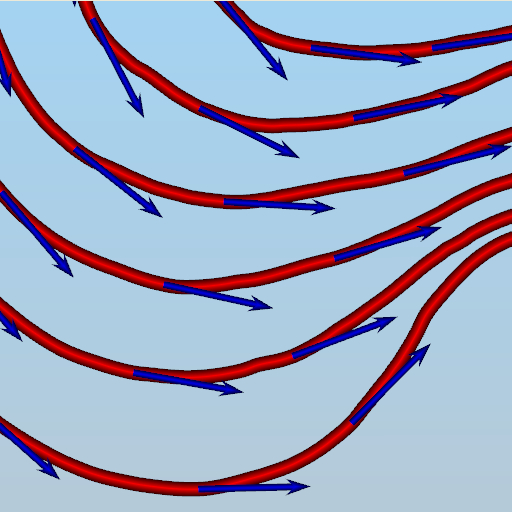
A pathline is the trajectory that an individual fluid particle will follow in an unsteady flow field, as shown in the figure below. The pathlines seeded from a rake are drawn in yellow while the underlying unsteady flow field is depicted using LIC textures. The concept of pathline is similar to that of streamline except that the underlying flow field is unsteady. Intuitively, if a small ball is placed into a water flow, and the water flow changes over time (i.e., an unsteady flow), the ball will follow the flow direction at each time step. In this case, the trajectory of the ball is a pathline.
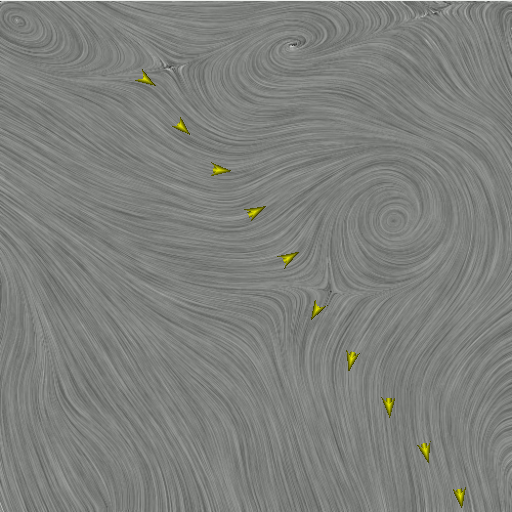
A streakline is the locus of points of all the fluid particles that have passed continuously through a particular spatial point in the past. Intuitively, if we place multiple small balls into the water flow at the same position but at different time steps, the streakline is the path by connecting all the balls in the placement order. Another real-world example of streaklines is smoke, where all particles are released at the same position, but at different time steps. As shown in the figure below, streaklines are closely related to pathlines. In the figure, the pathlines are drawn in yellow while the streakline is drawn in green. Given a set of pathlines traced from the same position at different time steps, connecting all points at the same time step forms a streakline.
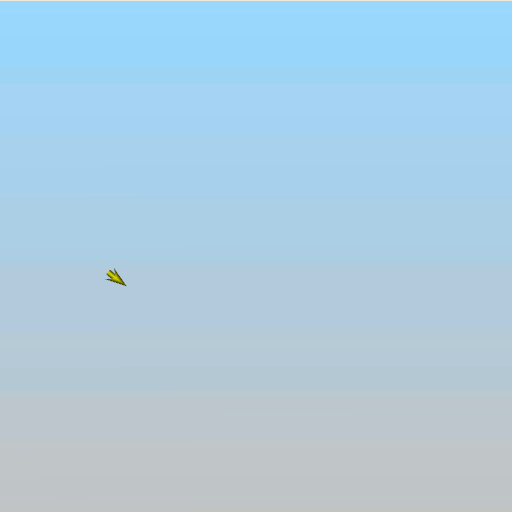
A timeline is a line formed by a set of fluid particles that were marked at a previous instant in time, creating a curve that is displaced over time as the particles move. Intuitively, imagine that we place several small balls into a water flow, and allow the balls to follow the flow. At a certain time step, the path that connects all the balls is a timeline. As shown in the figure below, timelines are closely related to pathlines. In the figure, the pathlines are drawn in yellow while the timeline is drawn in purple. Given a set of pathlines traced from the same time step at different positions, connecting all the points at the same time step forms a timeline.

A critical point is a position in a flow field domain where the velocity vanishes. For a 2D flow field, there are six types of critical points: saddles, repelling nodes, attracting nodes, centers, repelling focuses, and attracting focuses. The following figures illustrate the flow pattern around each of these six critical points.
 |
 |
 |
 |
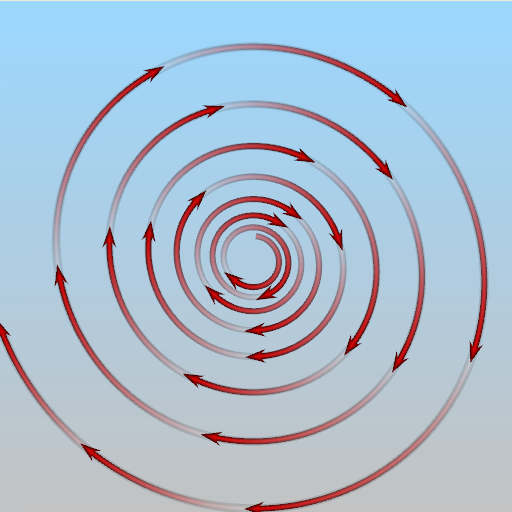 |
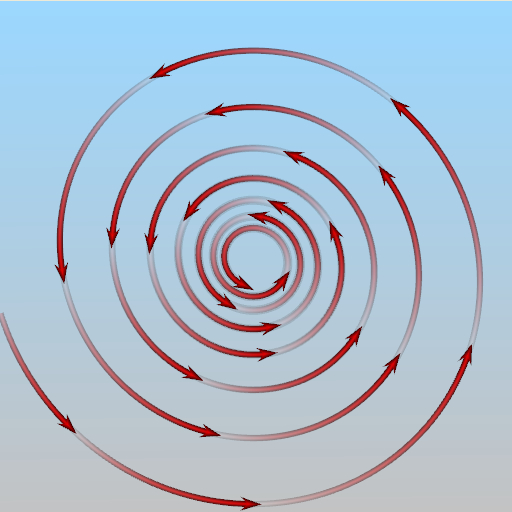 |
tar -xzvf 2dflowvis-linux32.tar.gzortar -xzvf 2dflowvis-linux64.tar.gz
./2dflowvis
Man Wang, Jun Tao, Chaoli Wang, Ching-Kuang Shene, and Seung Hyun Kim. FlowVisual: Design and Evaluation of a Visualization Tool for Teaching 2D Flow Field Concepts. Proceedings of American Society for Engineering Education Annual Conference, Atlanta, GA, pages 23.609.1-23.609-20, Jun 2013. [PDF] [WMV]
The 2D flow data used in this tutorial are slices extracted from a 3D hurricane simulation data set. We would like to thank Bill Kuo, Wei Wang, Cindy Bruyere, Tim Scheitlin, and Don Middleton of the U.S. National Center for Atmospheric Research (NCAR) and the U.S. National Science Foundation (NSF) for providing the Weather Research and Forecasting (WRF) Model simulation data of Hurricane Isabel. This hurricane simulation data set is made available through IEEE Visualization 2004 Contest.